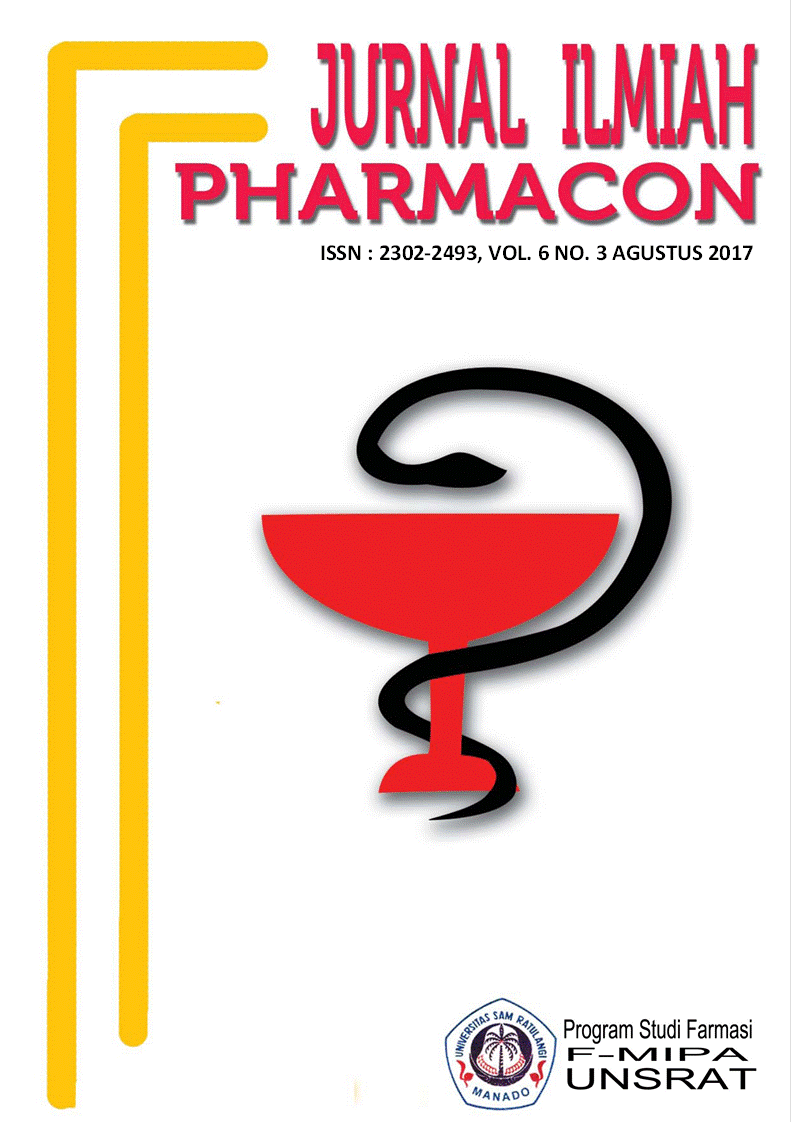PENGARUH PEMBERIAN EKSTRAK ETANOL DAUN DADAP AYAM (Erythrina variegata L.) TERHADAP KUALITAS SPERMATOZOA TIKUS PUTIH JANTAN GALUR WISTAR (Rattus norvegicus)
DOI:
https://doi.org/10.35799/pha.6.2017.16596Abstract
PENGARUH PEMBERIAN EKSTRAK ETANOL DAUN DADAP AYAM (Erythrina variegata L.) TERHADAP KUALITAS SPERMATOZOA TIKUS PUTIH JANTAN GALUR WISTAR (Rattus norvegicus)
Stefani Tjiphanata1), Edwin De Queljoe1), Sri Sudewi1)
1)Program Studi Farmasi FMIPA UNSRAT Manado, 95115
Â
ABSTRACT
Â
Â
           Spermatozoa are a sperm cell that has flagella and produced in spermatogenesis. To fertilize the ovum, the spermatozoa have to have a good quality. The Quality of spermatozoa is one of the most important elements to evaluate the male fertility. This study was being held to determine the effect of applying ethanol extract of Dadap leaf against the quality of white male Wistar rats (Rattus norvegicus)’s spermatozoa. This study is using a complete random design (CRD) approached, using 24 white male Wistar rats (Rattus norvegicus) divided into several groups where the group 1 as a non-treatment control group, while the group 2, 3 and 4 as the treatment groups with dosage of 200 mg, 400 mg and 800 mg, respectively. Treatment is given by oral with 1 cc once a day for 50 days follows the cycle of spermatogenesis. The observed variable included the quantity, motility and morphology of spermatozoa. The results of this study showed that the ethanol extract of Dadap leaf could reduce the quality of spermatozoa in terms of quantity, motility and morphology while based on statistic, the ethanol extract of Dadap leaf can only reduce the quality of spermatozoa in mophology aspect significantly. Â
Â
Keywords: Dadap leaf (Erythrina variegata L.), spermatozoa, white male wistar rats (Rattus norvegicus)
Â
ABSTRAK
Spermatozoa adalah sel kelamin jantan yang memiliki bulu cambuk dan dihasilkan dalam spermatogenesis. Untuk dapat membuahi sel telur, syarat yang harus dipenuhi spermatozoa adalah bahwa kualitas spermatozoa harus baik. Kualitas spermatozoa merupakan salah satu unsur penting untuk evaluasi kesuburan pria. Penelitian ini bertujuan untuk mengetahui pengaruh pemberian ekstrak etanol daun dadap ayam terhadap kualitas spermatozoa tikus putih jantan galur wistar (Rattus norvegicus). Penelitian ini menggunakan rancangan acak lengkap (RAL) dengan menggunakan 24 ekor tikus putih jantan galur wistar (Rattus norvegicus) yang dibagi atas beberapa kelompok dimana kelompok 1 sebagai kelompok kontrol tanpa perlakuan, kelompok 2, 3 dan 4 sebagai kelompok perlakuan denagn dosis secara berturut-turut 200 mg, 400 mg dan 800 mg. Perlakuan diberikan secara oral sekali sehari sebanyak 1 cc selama 50 hari sesuai siklus spermatogenesis. Variabel yang diamati meliputi jumlah, motilitas dan morfologi spermatozoa. Hasil penelitian ini menunjukkan bahwa ekstrak etanol daun dadap ayam dapat menurunkan kualitas spermatozoa dari segi kuantitas, motilitas serta morfologi spermatozoa sedangkan berdasarkan statistik ekstrak daun dadap ayam hanya dapat menurunkan kualitas spermatozoa dalam aspek morfologi spermatozoa secara signifikan.
Kata Kunci : Dadap Ayam (Erythrina variegata L.), spermatozoa, tikus putih jantan galur wistar (Rattus norvegicus)
Â
Downloads
Published
How to Cite
Issue
Section
License
Authors who publish with this journal agree to the following terms:
- Authors retain copyright and grant the journal right of first publication with the work simultaneously licensed under a Creative Commons Attribution-NonCommercial 4.0 International License that allows others to share the work with an acknowledgement of the work's authorship and initial publication in this journal.
- Authors are permitted and encouraged to post their work online (e.g., in institutional repositories or on their website) prior to and during the submission process, as it can lead to productive exchanges, as well as earlier and greater citation of published work (See The Effect of Open Access)










